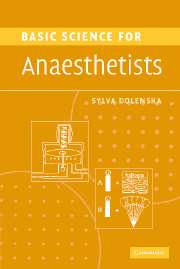Book contents
- Frontmatter
- Contents
- List of abbreviations and symbols
- List of figure captions
- Forewords
- Preface
- Preface to the second edition
- Part 1 Physics, mathematics, statistics, anaesthetic apparatus
- 1 Gas compression, relationship of volume, pressure and temperature
- 2 Real gas compression
- 3 Flow and resistance
- 4 Heat, vaporization and humidification
- 5 Simple mechanics 1: mass, force, pressure
- 6 Simple mechanics 2: work and power
- 7 Mathematical concepts
- 8 Exponentials 1: the curves
- 9 Exponentials 2: properties of exponential decay curve
- 10 Descriptive statistics
- 11 Presentation of data
- 12 Receiver operating characteristic curve
- 13 Gas supply and pressure
- 14 The circle system
- 15 The Mapleson A (Magill) breathing system
- 16 T-pieces
- 17 Lung filling with automatic lung ventilators
- Part 2 Clinical measurement
- Part 3a Physiology: the cardiovascular system
- Part 3b Physiology: the respiratory system
- Part 4 Pharmacology
- Further Reading
- Index
14 - The circle system
from Part 1 - Physics, mathematics, statistics, anaesthetic apparatus
Published online by Cambridge University Press: 13 August 2009
- Frontmatter
- Contents
- List of abbreviations and symbols
- List of figure captions
- Forewords
- Preface
- Preface to the second edition
- Part 1 Physics, mathematics, statistics, anaesthetic apparatus
- 1 Gas compression, relationship of volume, pressure and temperature
- 2 Real gas compression
- 3 Flow and resistance
- 4 Heat, vaporization and humidification
- 5 Simple mechanics 1: mass, force, pressure
- 6 Simple mechanics 2: work and power
- 7 Mathematical concepts
- 8 Exponentials 1: the curves
- 9 Exponentials 2: properties of exponential decay curve
- 10 Descriptive statistics
- 11 Presentation of data
- 12 Receiver operating characteristic curve
- 13 Gas supply and pressure
- 14 The circle system
- 15 The Mapleson A (Magill) breathing system
- 16 T-pieces
- 17 Lung filling with automatic lung ventilators
- Part 2 Clinical measurement
- Part 3a Physiology: the cardiovascular system
- Part 3b Physiology: the respiratory system
- Part 4 Pharmacology
- Further Reading
- Index
Summary
The circle system is a semiclosed or closed absorption system; with the absorber out of circuit it becomes a semiclosed rebreathing system. Low flow can be used because carbon dioxide (CO2) is absorbed and this gives economy of use and produces little pollution. Low flow has been defined as a total fresh gas flow of 1 l/minute, and minimum flow as 0.5 l/minute. Most new anaesthetic machines incorporate a circle system with absorber, unidirectional valves and exhaust valve removed from the patient end (see Figure 45). Modern highly efficient vaporizers are situated outside the circuit.
The most common technical problem with the circle system is disconnection of fresh gas flow at the fresh gas flow outlet and shutting off the expiratory valve when the intended mode of ventilation is spontaneous breathing (by leaving the control knob turned to ‘ventilator’ instead of ‘bag’).
Performance of the circle system under low fresh gas flow conditions
Inspired gas composition will be identical to the fresh gas composition at high fresh gas flows, as the expired gas will be flushed out of the system, and CO2 is absorbed. When reducing the gas flow to low levels, the expired gas will make an increasingly bigger contribution to the gas composition inside the circuit. Oxygen flow must not be reduced below the minimum 250 ml/min, the basic metabolic requirement being 200 ml/min. The concentration effect will influence the inspired gas composition at induction, when anaesthetic (nitrous oxide, or N2O) uptake is high.
- Type
- Chapter
- Information
- Basic Science for Anaesthetists , pp. 54 - 57Publisher: Cambridge University PressPrint publication year: 2006



